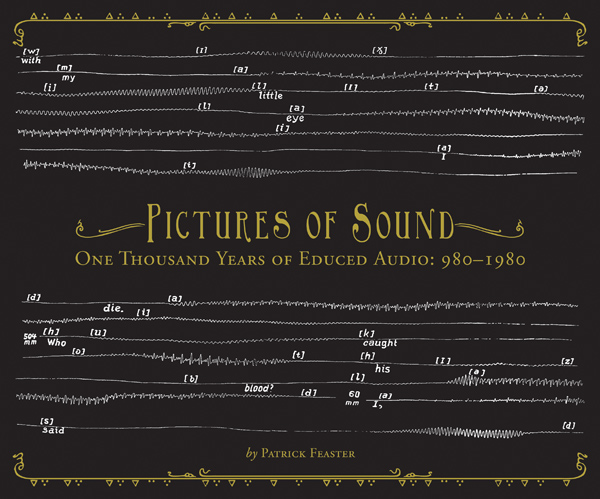Patrick Feaster: Pictures of Sound: One Thousand Years of Educed Audio, 980-1980 + CD (2012)
Filed under book, sound recording | Tags: · history of technology, media archeology, phonograph, sound, sound recording, technology

“Using modern technology, Patrick Feaster is on a mission to resurrect long-vanished voices and sounds—many of which were never intended to be revived.
Over the past thousand years, countless images have been created to depict sound in forms that theoretically could be “played” just as though they were modern sound recordings. Now, for the first time in history, this compilation uses innovative digital techniques to convert historic “pictures of sound” dating back as far as the Middle Ages directly into meaningful audio. It contains the world’s oldest known “sound recordings” in the sense of sound vibrations automatically recorded out of the air—the groundbreaking phonautograms recorded in Paris by Édouard-Léon Scott de Martinville in the 1850s and 1860s—as well as the oldest gramophone records available anywhere for listening today, including inventor Emile Berliner’s recitation of Der Handschuh, played back from an illustration in a magazine, which international news media recently proclaimed to be the oldest audible “record” in the tradition of 78s and vintage vinyl. Other highlights include the oldest known recording of identifiable words spoken in the English language (1878) and the world’s oldest surviving “trick recording” (1889). But Pictures of Sound pursues the thread even further into the past than that by “playing” everything from medieval music manuscripts to historic telegrams, and from seventeenth-century barrel organ programs to eighteenth-century “notations” of Shakespearean recitation.
In short, this isn’t just another collection of historical audio—it redefines what “historical audio” is.”
Publisher Dust-to-Digital, Atlanta/GA, 2012
144 pages, with 164 images
via prohairesis
Review: Randall Roberts (LA Times).
FirstSounds.org initiative
Patrick Feaster discusses Pictures of Sound (video, 36 min)
Author
Publisher
PDF, PDF (29 MB, updated on 2018-3-29)
ZIP (CD, 92 MB, ZIP’d OGG, updated on 2016-12-23)
Sensate: A Journal for Experiments in Critical Media Practice (2012-)
Filed under journal | Tags: · archive, art, digital humanities, ethnography, film, history of technology, media archeology, media art, photography, sensory ethnography, sociology, sound, video, visual anthropology

Sensate is a peer-reviewed, issueless, open-access, media-based journal for the creation, presentation, and critique of innovative projects in the arts, humanities, and sciences. Its mission is to provide a scholarly and artistic forum for experiments in critical media practices that expand academic discourse by taking us beyond the margins of the printed page. Fundamental to this expansion is a re-imagining of what constitutes a work of scholarship or art.
Editors-in-Chief: Lindsey Lodhie, Peter McMurray, Joana Pimenta, and Elizabeth Watkins
Creative Commons 3.0 Attribution license
Dolores L Augustine: Red Prometheus: Engineering and Dictatorship in East Germany, 1945-1990 (2007)
Filed under book | Tags: · cold war, communism, east germany, engineering, germany, history of science, history of technology, ideology, politics, socialism, soviet union, technology

“In Cold War-era East Germany, the German tradition of science-based technology merged with a socialist system that made technological progress central to its ideology. Technology became an important part of East German socialist identity—crucial to how Communists saw their system and how citizens saw their state. In Red Prometheus, Dolores Augustine examines the relationship between a dictatorial system and the scientific and engineering communities in East Germany from the end of the Second World War through the 1980s.
Drawing on newly opened archives and extensive interviews, and including many illlustrations and photographs that have never before been published, Augustine looks in detail at individual scientists’ interactions with the East German system, examining the effectiveness of their resistance against the party’s totalitarian impulses. She explains why many German scientists and engineers who were deported to the Soviet Union after World War II returned to East Germany rather than defecting to the capitalist West, traces scientists’ attempts to hold on to some aspects of professional autonomy, and describes challenges to their professional identity on the factory floor. Augustine examines the quality of science and technology produced under Communist rule, looking at failed research projects and clashing cultures of innovation. She looks at technological myth-building in science fiction and propaganda. She explores individual career strategies, including the role played by gender in high-tech professions, and the ways that both enterprises and individuals responded to increasing state and party control of research during the 1980s. We cannot understand the economic choices made by East Germany, Augustine argues, unless we understand the cultural values reflected in the East German belief in technology as indispensable to progress and industrial development.”
Publisher MIT Press, 2007
Transformations: Studies in the History of Science and Technology series
ISBN 0262012367, 9780262012362
381 pages

